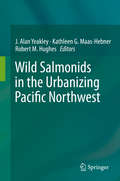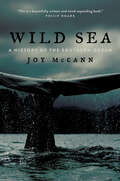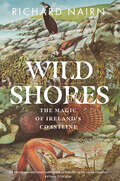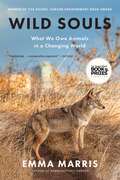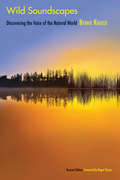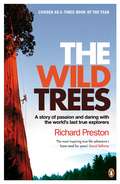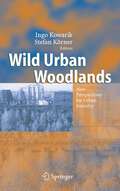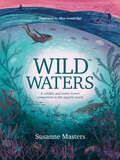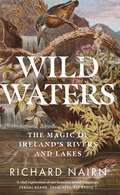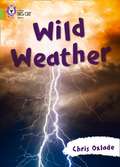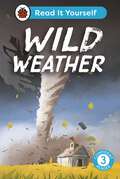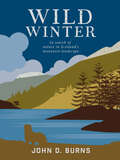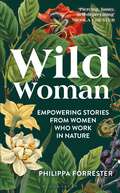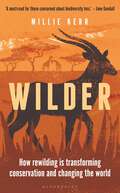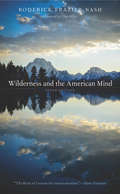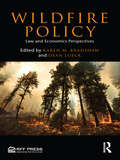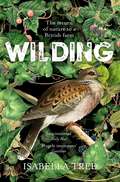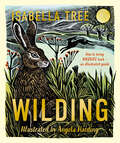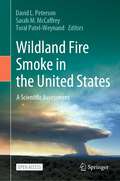- Table View
- List View
Wild Salmonids in the Urbanizing Pacific Northwest
by J. Alan Yeakley Kathleen G. Maas-Hebner Robert M. HughesWild salmon, trout, char, grayling, and whitefish (collectively salmonids) have been a significant local food and cultural resource for Pacific Northwest peoples for millennia. The location, size, and distribution of urban areas along streams, rivers, estuaries, and coasts directly and indirectly alter and degrade wild salmonid populations and their habitats. Although urban and exurban areas typically cover a smaller fraction of the landscape than other land uses combined, they have profound consequences for local ecosystems, aquatic and terrestrial populations, and water quality and quantity.
Wild Sea: A History of the Southern Ocean
by Joy McCann“The Southern Ocean is a wild and elusive place, an ocean like no other. With its waters lying between the Antarctic continent and the southern coastlines of Australia, New Zealand, South America, and South Africa, it is the most remote and inaccessible part of the planetary ocean, the only part that flows around Earth unimpeded by any landmass. It is notorious amongst sailors for its tempestuous winds and hazardous fog and ice. Yet it is a difficult ocean to pin down. Its southern boundary, defined by the icy continent of Antarctica, is constantly moving in a seasonal dance of freeze and thaw. To the north, its waters meet and mingle with those of the Atlantic, Indian, and Pacific Oceans along a fluid boundary that defies the neat lines of a cartographer.” So begins Joy McCann’s Wild Sea, the remarkable story of the world’s remote Southern, or Antarctic, Ocean. Unlike the Pacific, Atlantic, Indian, and Arctic Oceans with their long maritime histories, little is known about the Southern Ocean. This book takes readers beyond the familiar heroic narratives of polar exploration to explore the nature of this stormy circumpolar ocean and its place in Western and Indigenous histories. Drawing from a vast archive of charts and maps, sea captains’ journals, whalers’ log books, missionaries’ correspondence, voyagers’ letters, scientific reports, stories, myths, and her own experiences, McCann embarks on a voyage of discovery across its surfaces and into its depths, revealing its distinctive physical and biological processes as well as the people, species, events, and ideas that have shaped our perceptions of it. The result is both a global story of changing scientific knowledge about oceans and their vulnerability to human actions and a local one, showing how the Southern Ocean has defined and sustained southern environments and people over time. Beautifully and powerfully written, Wild Sea will raise a broader awareness and appreciation of the natural and cultural history of this little-known ocean and its emerging importance as a barometer of planetary climate change.
Wild Sea: A History of the Southern Ocean
by Joy McCann“The Southern Ocean is a wild and elusive place, an ocean like no other. With its waters lying between the Antarctic continent and the southern coastlines of Australia, New Zealand, South America, and South Africa, it is the most remote and inaccessible part of the planetary ocean, the only part that flows around Earth unimpeded by any landmass. It is notorious amongst sailors for its tempestuous winds and hazardous fog and ice. Yet it is a difficult ocean to pin down. Its southern boundary, defined by the icy continent of Antarctica, is constantly moving in a seasonal dance of freeze and thaw. To the north, its waters meet and mingle with those of the Atlantic, Indian, and Pacific Oceans along a fluid boundary that defies the neat lines of a cartographer.” So begins Joy McCann’s Wild Sea, the remarkable story of the world’s remote Southern, or Antarctic, Ocean. Unlike the Pacific, Atlantic, Indian, and Arctic Oceans with their long maritime histories, little is known about the Southern Ocean. This book takes readers beyond the familiar heroic narratives of polar exploration to explore the nature of this stormy circumpolar ocean and its place in Western and Indigenous histories. Drawing from a vast archive of charts and maps, sea captains’ journals, whalers’ log books, missionaries’ correspondence, voyagers’ letters, scientific reports, stories, myths, and her own experiences, McCann embarks on a voyage of discovery across its surfaces and into its depths, revealing its distinctive physical and biological processes as well as the people, species, events, and ideas that have shaped our perceptions of it. The result is both a global story of changing scientific knowledge about oceans and their vulnerability to human actions and a local one, showing how the Southern Ocean has defined and sustained southern environments and people over time. Beautifully and powerfully written, Wild Sea will raise a broader awareness and appreciation of the natural and cultural history of this little-known ocean and its emerging importance as a barometer of planetary climate change.
Wild Sea: A History of the Southern Ocean
by Joy McCann“The Southern Ocean is a wild and elusive place, an ocean like no other. With its waters lying between the Antarctic continent and the southern coastlines of Australia, New Zealand, South America, and South Africa, it is the most remote and inaccessible part of the planetary ocean, the only part that flows around Earth unimpeded by any landmass. It is notorious amongst sailors for its tempestuous winds and hazardous fog and ice. Yet it is a difficult ocean to pin down. Its southern boundary, defined by the icy continent of Antarctica, is constantly moving in a seasonal dance of freeze and thaw. To the north, its waters meet and mingle with those of the Atlantic, Indian, and Pacific Oceans along a fluid boundary that defies the neat lines of a cartographer.” So begins Joy McCann’s Wild Sea, the remarkable story of the world’s remote Southern, or Antarctic, Ocean. Unlike the Pacific, Atlantic, Indian, and Arctic Oceans with their long maritime histories, little is known about the Southern Ocean. This book takes readers beyond the familiar heroic narratives of polar exploration to explore the nature of this stormy circumpolar ocean and its place in Western and Indigenous histories. Drawing from a vast archive of charts and maps, sea captains’ journals, whalers’ log books, missionaries’ correspondence, voyagers’ letters, scientific reports, stories, myths, and her own experiences, McCann embarks on a voyage of discovery across its surfaces and into its depths, revealing its distinctive physical and biological processes as well as the people, species, events, and ideas that have shaped our perceptions of it. The result is both a global story of changing scientific knowledge about oceans and their vulnerability to human actions and a local one, showing how the Southern Ocean has defined and sustained southern environments and people over time. Beautifully and powerfully written, Wild Sea will raise a broader awareness and appreciation of the natural and cultural history of this little-known ocean and its emerging importance as a barometer of planetary climate change.
Wild Sea: A History of the Southern Ocean
by Joy McCann“The Southern Ocean is a wild and elusive place, an ocean like no other. With its waters lying between the Antarctic continent and the southern coastlines of Australia, New Zealand, South America, and South Africa, it is the most remote and inaccessible part of the planetary ocean, the only part that flows around Earth unimpeded by any landmass. It is notorious amongst sailors for its tempestuous winds and hazardous fog and ice. Yet it is a difficult ocean to pin down. Its southern boundary, defined by the icy continent of Antarctica, is constantly moving in a seasonal dance of freeze and thaw. To the north, its waters meet and mingle with those of the Atlantic, Indian, and Pacific Oceans along a fluid boundary that defies the neat lines of a cartographer.” So begins Joy McCann’s Wild Sea, the remarkable story of the world’s remote Southern, or Antarctic, Ocean. Unlike the Pacific, Atlantic, Indian, and Arctic Oceans with their long maritime histories, little is known about the Southern Ocean. This book takes readers beyond the familiar heroic narratives of polar exploration to explore the nature of this stormy circumpolar ocean and its place in Western and Indigenous histories. Drawing from a vast archive of charts and maps, sea captains’ journals, whalers’ log books, missionaries’ correspondence, voyagers’ letters, scientific reports, stories, myths, and her own experiences, McCann embarks on a voyage of discovery across its surfaces and into its depths, revealing its distinctive physical and biological processes as well as the people, species, events, and ideas that have shaped our perceptions of it. The result is both a global story of changing scientific knowledge about oceans and their vulnerability to human actions and a local one, showing how the Southern Ocean has defined and sustained southern environments and people over time. Beautifully and powerfully written, Wild Sea will raise a broader awareness and appreciation of the natural and cultural history of this little-known ocean and its emerging importance as a barometer of planetary climate change.
Wild Shores: The Magic of Ireland’s Coastline
by Richard NairnFollowing the Irish coast in a clockwise direction, acclaimed ecologist Richard Nairn travels by boat, on foot and sometimes by air to visit the best remaining wild places, including islands, cliffs, beaches and dunes.The result is a unique mix of nature, history, science and a reflection on the author’s personal experiences of exploring Ireland’s coast. By viewing the Irish coastline from the sea, Richard gains a unique perspective on the island. And along the way, he recalls a lifetime spent studying nature.‘An affectionate and timely celebration of Ireland’s richly varied coastline’ Bryan Dobson‘A great read – whatever part of the coast you visit’ Éanna Ní Lamhna‘A brilliant and timely odyssey around our precious, precarious shores’ Professor John Brannigan, University College Dublin‘An exhilarating journey right around our coastline’ Paddy Woodworth, Journalist and author‘An intimate, inspiring and lovely read about Ireland's shorelines: its places and spaces’ Professor Robert Devoy, Lead Editor of The Coastal Atlas of Ireland
Wild Souls: Freedom and Flourishing in the Non-Human World
by Emma MarrisFrom an acclaimed environmental writer, a groundbreaking and provocative new vision for our relationships with--and responsibilities toward--the planet's wild animals.Protecting wild animals and preserving the environment are two ideals so seemingly compatible as to be almost inseparable. But in fact, between animal welfare and conservation science there exists a space of underexamined and unresolved tension: wildness itself. When is it right to capture or feed wild animals for the good of their species? How do we balance the rights of introduced species with those already established within an ecosystem? Can hunting be ecological? Are any animals truly wild on a planet that humans have so thoroughly changed? No clear guidelines yet exist to help us resolve such questions. Transporting readers into the field with scientists tackling these profound challenges, Emma Marris tells the affecting and inspiring stories of animals around the globe--from Peruvian monkeys to Australian bilbies, rare Hawai'ian birds to majestic Oregon wolves. And she offers a companionable tour of the philosophical ideas that may steer our search for sustainability and justice in the non-human world. Revealing just how intertwined animal life and human life really are, Wild Souls will change the way we think about nature-and our place within it.
Wild Soundscapes: Discovering the Voice of the Natural World, Revised Edition (The\future Ser.)
by Bernie KrauseThrough his organization Wild Sanctuary, Bernie Krause has traveled the globe to hear and record the sounds of diverse natural habitats. Wild Soundscapes, first published in 2002, inspires readers to follow in Krause’s footsteps. The book enchantingly shows how to find creature symphonies (or, as Krause calls them, “biophonies”); use simple microphones to hear more; and record, mix, and create new expressions with the gathered sounds. After reading this book, readers will feel compelled to investigate a wide range of habitats and animal sounds, from the conversations of birds and howling sand dunes to singing anthills. This rewritten and updated edition explains the newest technological advances and research, encouraging readers to understand the earth’s soundscapes in ways previously unimaginable. With links to the sounds that are discussed in the text, this accessible and engaging guide to natural soundscapes will captivate amateur naturalists, field recordists, musicians, and anyone else who wants to fully appreciate the sounds of our natural world.
The Wild Trees: A Story of Passion and Daring with the World's Last True Explorers
by Richard PrestonWhen Steve Sillett was 19 years old, he free-climbed – with no safety equipment and no training – one of the tallest trees on earth, in the redwood forests of Prairie Creek, California. 30 storeys above the ground he glimpsed an undiscovered ecosystem, and his passion for that astonishing world would transform the rest of his life. Over the next twenty years, Sillett and a close group of friends charted this system, discovering mosses and lichen never seen before, and travelling among branches so densely interwoven they form incredible sky-high walkways. There are only twenty people on earth who have climbed the world’s tallest trees and who know their location. In writing The Wild Trees, Richard Preston not only managed to gain access to this group, but began to climb these hidden giants himself, putting his life in danger in order to understand the powerful connection between the massive trees and the world’s last great explorers.
Wild Urban Woodlands: New Perspectives for Urban Forestry
by Ingo Kowarik Stefan KörnerThis book provides a first overview of the phemonemon of post-industrial urban wilderness: urban landscapes once shaped by heavy industry that are being re-colonized naturally by forests. These new types of urban woodlands are often overlooked by ecologists, foresters and planners. Individual chapters consider urban woodlands from the perspectives of ecology, environmental sociology, forestry, nature conservation and landscape architecture.
Wild Visions: Wilderness as Image and Idea
by Ben A Minteer Mark Klett Stephen J. PyneA stunning combination of landscape photography and thematic essays exploring how the concept of wilderness has evolved over time Our ideas of wilderness have evolved dramatically over the past one hundred and fifty years, from a view of wild country as an inviolable “place apart” to one that exists only within the matrix of human activity. This shift in understanding has provoked complicated questions about the importance of the wild in American environmentalism, as well as new aesthetic expectations as we reframe the wilderness as (to some degree) a human creation.Wild Visions is distinctive in its union of landscape photography and environmental thought, a merging of short, thematic essays with a striking visual narrative. Often, the wild is viewed in binary terms: either revered as sacred and ecologically pure or dismissed as spoiled by human activities. This book portrays wilderness instead as an evolving gamut of understandings, a collage of views and ideas that is still in process.
Wild Waters: A wildlife and water lover's companion to the aquatic world
by Susanne MastersAbout seventy-one per cent of the Earth’s surface is water, and even on dry land we remain closely connected to aquatic life. It provides us with oxygen, food, medicine and materials. Wild waterlife infiltrates our lives in many surprising ways. Every other breath we take is filled with oxygen provided by ocean-dwelling microscopic plants. A type of seaweed provides a means to directly test whether people are infected with viruses, including Covid-19. Robotics design takes inspiration from a pike’s ability to accelerate with greater g-force than a Porsche.Wild Waters by Susanne Masters is a celebration of the breadth of wildlife that can be found in and around our varied waterways, from oceans and rivers to rock pools and ponds. Armchair explorers can read a fascinating account of how aquatic plants and animals enrich human life. Swimmers, paddleboarders, dog walkers, families and anyone with a passion for the great outdoors can learn about local wildlife, including when and where to look for different species without causing any harm.With stunning illustrations by Alice Goodridge, Wild Waters provides a tantalising insight into the world beneath the surface.
Wild Weather: Band 11/Lime (Collins Big Cat)
by Chris Oxlade Collins Big Cat StaffFrom whirling sandstorms to freezing blizzards, take a journey around the Earth to see some of its wildest weather. This is a Band 11/Lime book in the Collins Big Cat reading programme which has longer sentence structures and a greater use of literary language. This is an information book and includes a comprehensive glossary on page 29 to aid comprehension. All the wild weather is brought together neatly on pages 30 and 31, with a handy table of all weather types covered, along with locations and causes. This story supports learning around geography and will help children identify seasonal and daily weather patterns in the United Kingdom and the location of hot and cold areas of the world in relation to the Equator and the North and South Poles.
Wild Weather: Read It Yourself - Level 3 Confident Reader (Read It Yourself)
by LadybirdWhat is the weather like where you live? In Antarctica it is very cold, but Death Valley is very hot. Read all about monsoons, tornadoes and hurricanes in different places around the world with wild weather. Wild Weather is from Confident Reader Level 3 and is perfect for more confident readers aged from 6+ who can read simple stories with help.Each book has been carefully checked by educational and subject consultants and includes comprehension puzzles, book band information, and tips for helping children with their reading. With five levels to take children from first phonics to fluent reading and a wide range of different stories and topics for every interest, Read It Yourself helps children build their confidence and begin reading for pleasure.
Wild Winter: In search of nature in Scotland's mountain landscape
by John D. BurnsIn Wild Winter, John D. Burns, bestselling author of The Last Hillwalker and Bothy Tales, sets out to rediscover Scotland’s mountains, remote places and wildlife in the darkest and stormiest months. He traverses the country from the mouth of the River Ness to the Isle of Mull, from remote Sutherland to the Cairngorms, in search of rutting red deer, pupping seals, minke whales, beavers, pine martens, mountain hares and otters. In the midst of the fierce weather, John’s travels reveal a habitat in crisis, and many of these wild creatures prove elusive as they cling on to life in the challenging Highland landscape.As John heads deeper into the winter, he notices the land fighting back with signs of regeneration. He finds lost bothies, old friendships and innovative rewilding projects, and – as Covid locks down the nation – reflects on what the outdoors means to hillwalkers, naturalists and the folk who make their home in the Highlands.Wild Winter is a reminder of the wonder of nature and the importance of caring for our environment. In his winter journey through the mountains and bothies of the Highlands, John finds adventure, humour and a deep sense of connection with this wild land.
Wild Woman: Empowering Stories from Women who Work in Nature
by Philippa ForresterAn engaging blend of conservation stories and humorous, personal anecdotes from Philippa Forrester about women who, like her, choose to live and work in the wild.Surviving in the wilderness has long been associated with men, and conservation and environmental biology have traditionally been male-dominated subjects. Yet many remarkable women also choose to live and work in wild and challenging landscapes. In Wild Woman, Philippa Forrester considers the grit and determination required for women to maintain connections to wildlife and shares stories of female conservation heroes and other extraordinary wild women working in nature. Talking to women from around the world, Philippa studies and celebrates what it means to be a wild woman. From the sixteenth-century botanist who was the first woman to circumnavigate the globe to modern-day women responding to bear attacks in Yellowstone, working to rewild reserves in South Africa, photographing Caribou in the Arctic and more, Philippa examines how these women benefit from a life spent in the wilderness and also considers what the natural world gains from them. Relating some of her own experiences from three decades spent travelling around the world and working in some of the wildest places on Earth, Philippa asks: what does it take for a woman to live or work in the wild?
Wild Woman: Empowering Stories from Women who Work in Nature
by Philippa ForresterAn engaging blend of conservation stories and humorous, personal anecdotes from Philippa Forrester about women who, like her, choose to live and work in the wild.Surviving in the wilderness has long been associated with men, and conservation and environmental biology have traditionally been male-dominated subjects. Yet many remarkable women also choose to live and work in wild and challenging landscapes. In Wild Woman, Philippa Forrester considers the grit and determination required for women to maintain connections to wildlife and shares stories of female conservation heroes and other extraordinary wild women working in nature. Talking to women from around the world, Philippa studies and celebrates what it means to be a wild woman. From the sixteenth-century botanist who was the first woman to circumnavigate the globe to modern-day women responding to bear attacks in Yellowstone, working to rewild reserves in South Africa, photographing Caribou in the Arctic and more, Philippa examines how these women benefit from a life spent in the wilderness and also considers what the natural world gains from them. Relating some of her own experiences from three decades spent travelling around the world and working in some of the wildest places on Earth, Philippa asks: what does it take for a woman to live or work in the wild?
Wilder: How Rewilding is Transforming Conservation and Changing the World
by Millie KerrWilder takes readers on a global rewilding journey, exploring innovative and eye-opening projects led by a diverse group of passionate conservationists. Rewilding is a radical new approach to wildlife conservation that offers remarkable potential. If conservation seeks to preserve what remains and stave off further decline, rewilding goes further, seeking to restore entire ecosystems. It involves a spectrum of conservation options; at one end is a 'passive' approach prioritising ecological restoration – in essence, leaving land to recover naturally. At the other is what might be termed 'active' rewilding, where habitats are actively restored and keystone species reintroduced to quicken the process of recovery. The stakes are high in active rewilding. Large mammal translocations and wildlife corridors running through densely populated areas are high-risk, high-reward initiatives. In this timely and exciting contribution to a wider conversation about our relationship with the natural world, wildlife journalist Millie Kerr takes readers on a global journey of discovery. She considers the practicalities and possibilities of ecological restoration around the world, while exploring first-hand some of the most ambitious undertakings occurring today, many of which involve species reintroductions in the Global South. Wilder details the return of jaguars to an Argentinian national park, the first-ever pangolin reintroduction project in South Africa, and the ways in which giant tortoises are aiding the recovery of ecosystems throughout the Galápagos Islands, among many others. At an urgent moment in the international fight against biodiversity loss, Wilder's message is one of innovation and optimism. By focusing on conservation success stories and showing that there are bands of determined conservationists fighting for a better future, Wilder inspires us all to become part of the solution.
Wilderness and the American Mind: Fifth Edition
by Roderick Frazier NashRoderick Nash’s classic study of changing attitudes toward wilderness during American history, as well as the origins of the environmental and conservation movements, has received wide acclaim since its initial publication in 1967. The Los Angeles Times listed it among the one hundred most influential books published in the last quarter century, Outside Magazine included it in a survey of “books that changed our world,” and it has been called the “Book of Genesis for environmentalists.” For the fifth edition, Nash has written a new preface and epilogue that brings Wilderness and the American Mind into dialogue with contemporary debates about wilderness. Char Miller’s foreword provides a twenty-first-century perspective on how the environmental movement has changed, including the ways in which contemporary scholars are reimagining the dynamic relationship between the natural world and the built environment.
Wildfire Policy: Law and Economics Perspectives
by Karen M. Bradshaw Dean LueckDuring the five decades since its origin, law and economics has provided an influential framework for addressing a wide array of areas of law ranging from judicial behaviour to contracts. This book will reflects the first-ever forum for law and economics scholars to apply the analysis and methodologies of their field to the subject of wildfire. The only modern legal work on wildfire, the book brings together leading scholars to consider questions such as: How can public policy address the effects of climate change on wildfire, and wildfire on climate change? Are the environmental and fiscal costs of ex ante prevention measures justified? What are the appropriate levels of prevention and suppression responsibility borne by private, state, and federal actors? Can tort liability provide a solution for realigning the grossly distorted incentives that currently exist for private landowners and government firefighters? Do the existing incentives in wildfire institutions provide incentives for efficient private and collective action and how might they be improved?
Wildfire Policy: Law and Economics Perspectives
by Dean Lueck Karen M. BradshawDuring the five decades since its origin, law and economics has provided an influential framework for addressing a wide array of areas of law ranging from judicial behaviour to contracts. This book will reflects the first-ever forum for law and economics scholars to apply the analysis and methodologies of their field to the subject of wildfire. The only modern legal work on wildfire, the book brings together leading scholars to consider questions such as: How can public policy address the effects of climate change on wildfire, and wildfire on climate change? Are the environmental and fiscal costs of ex ante prevention measures justified? What are the appropriate levels of prevention and suppression responsibility borne by private, state, and federal actors? Can tort liability provide a solution for realigning the grossly distorted incentives that currently exist for private landowners and government firefighters? Do the existing incentives in wildfire institutions provide incentives for efficient private and collective action and how might they be improved?
Wilding: The Return of Nature to a British Farm
by Isabella Tree'A passionately personal, robustly argued and uplifting book . . . One of the landmark ecological books of the decade.' Sunday Times 'Books of the Year'In Wilding, Isabella Tree tells the story of the ‘Knepp experiment’, a pioneering rewilding project in West Sussex, using free-roaming grazing animals to create new habitats for wildlife. Part gripping memoir, part fascinating account of the ecology of our countryside, Wilding is, above all, an inspiring story of hope.Forced to accept that intensive farming on the heavy clay of their land at Knepp was economically unsustainable, Isabella Tree and her husband Charlie Burrell made a spectacular leap of faith: they decided to step back and let nature take over. Thanks to the introduction of free-roaming cattle, ponies, pigs and deer – proxies of the large animals that once roamed Britain – the 3,500 acre project has seen extraordinary increases in wildlife numbers and diversity in little over a decade.Extremely rare species, including turtle doves, nightingales, peregrine falcons, lesser spotted woodpeckers and purple emperor butterflies, are now breeding at Knepp, and populations of other species are rocketing. The Burrells’ degraded agricultural land has become a functioning ecosystem again, heaving with life – all by itself.Personal and inspirational, Wilding is an astonishing account of the beauty and strength of nature, when it is given as much freedom as possible.
Wilding: How To Bring Wildlife Back - An Illustrated Guide
by Isabella TreeWilding: How to Bring Wildlife Back - An Illustrated Guide is a stunningly beautiful gift book written by Isabella Tree which tells the story of the Knepp Estate in West Sussex. It is illustrated in full colour with lino prints and watercolours by Angela Harding (A Year Unfolding) and photographs from Knepp.Knepp is now home to some of the rarest and most beautiful creatures in the UK, including nightingales, kingfishers, turtle doves and peregrine falcons, hazel dormice and harvest mice, scarce chaser dragonflies and purple emperor butterflies. The sheer abundance of life is staggering too. When you walk out into the scrubland on an early spring morning the sound of birdsong is so loud it feels like it’s vibrating in your lungs. This is the story of Knepp, and a guide telling you how to bring wildlife back where you live.Includes timelines, an indepth look at rewilding, spotlight features about native animals including species that have returned and thrive - butterflies, bats, owls and beetles. There are accessible in-garden activities to 're-wild' your own spaces and the book encourages you to slow down and observe the natural world around you, understand the connections between species and habitats, and the huge potential for life right on your doorstep.
Wildland Fire Smoke in the United States: A Scientific Assessment
by Toral Patel-Weynand David L. Peterson Sarah M. McCaffreyThis open access book synthesizes current information on wildland fire smoke in the United States, providing a scientific foundation for addressing the production of smoke from wildland fires. This will be increasingly critical as smoke exposure and degraded air quality are expected to increase in extent and severity in a warmer climate. Accurate smoke information is a foundation for helping individuals and communities to effectively mitigate potential smoke impacts from wildfires and prescribed fires. The book documents our current understanding of smoke science for (1) primary physical, chemical, and biological issues related to wildfire and prescribed fire, (2) key social issues, including human health and economic impacts, and (3) current and anticipated management and regulatory issues. Each chapter provides a summary of priorities for future research that provide a roadmap for developing scientific information that can improve smoke and fire management over the next decade.
